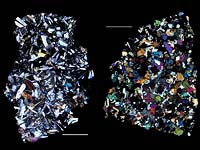|
COMETS EARTH JUPITER KUIPER BELT MARS MERCURY METEORITES NEPTUNE OORT CLOUD PLUTO SATURN SOLAR SYSTEM SPACE SUN URANUS VENUS ORDER PRINTS
PHOTO CATEGORIES SCIENCEVIEWS AMERICAN INDIAN AMPHIBIANS BIRDS BUGS FINE ART FOSSILS THE ISLANDS HISTORICAL PHOTOS MAMMALS OTHER PARKS PLANTS RELIGIOUS REPTILES SCIENCEVIEWS PRINTS
|
Related Documents
Download Options
The HED (howardite, eucrite and diogenite) meteorites are a large group of meteorites believed to originate from Vesta, a hypothesis that is consistent with current Dawn observations. The eucrites are crystallized lavas that have the composition of basalt, the most common lava type on the Earth. The QUE 97053 (left) and EET 90020 (right) eucrites, pictured here, were recovered in Antarctica. These images are of thin slices of the meteorites as viewed through a polarizing microscope. The white bars in the images, each 2.5 millimeters long, indicate the scale. When polarized light passes through thin slices of rock, different minerals have different colors. QUE97053 (left) consists mostly of elongated gray crystals of feldspar (calcium aluminum silicate) and brightly colored grains of pyroxene (magnesium iron silicate). The texture of this rock is what would be expected from crystallization of a molten magma. EET90020 (right) has similar mineralogy but a recrystallized texture of equant grains formed by later heating. Equant grains have the same or roughly the same dimensions in all directions. Eucrites like these comprise some fraction of Vesta's surface. Their compositions can be compared with observations from various instruments aboard Dawn. They can be compared with the VIR (Visible and Infrared Imaging Spectrometer) spectra to determine mineralogy and with the GRaND (Gamma Ray and Neutron Detector) observations to calibrate and interpret the GRaND instrument's responses. |
